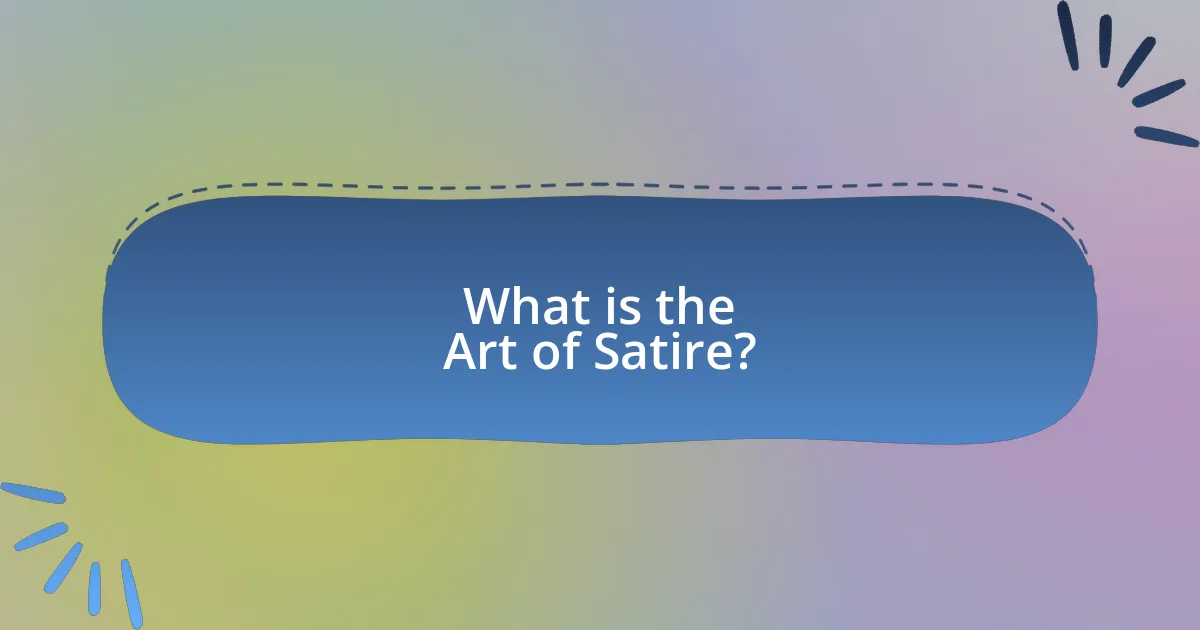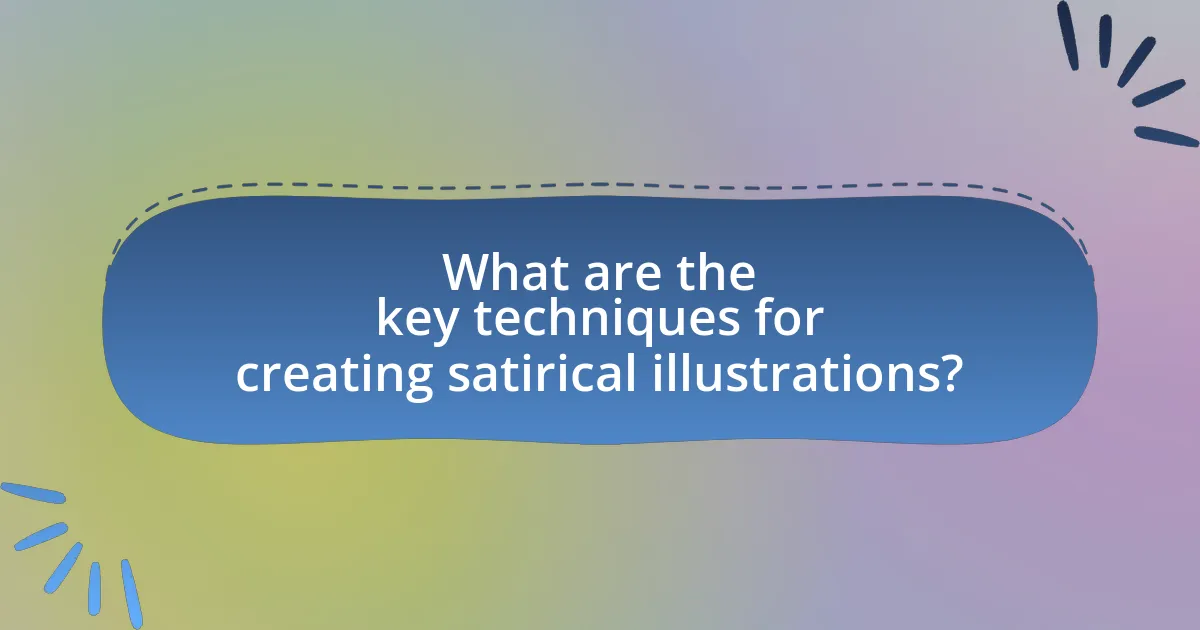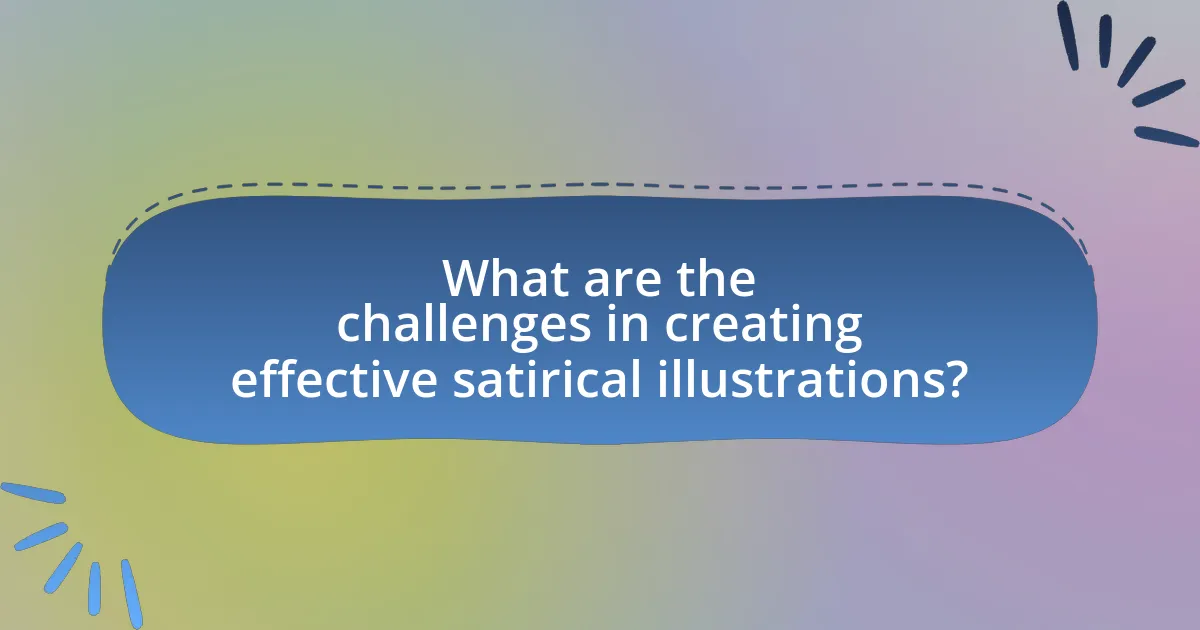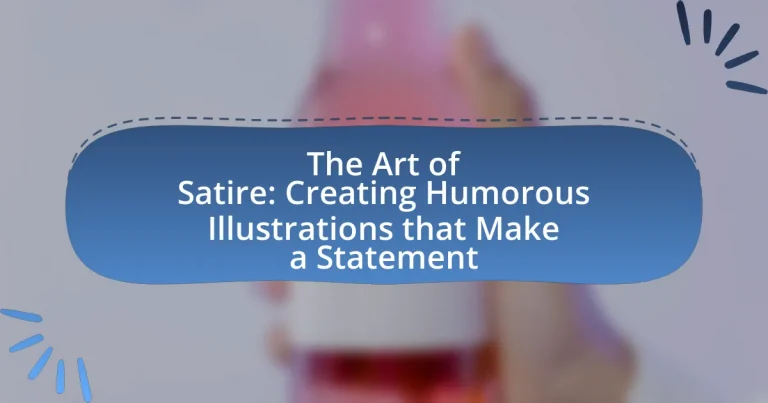The Art of Satire is a literary and artistic technique that employs humor, irony, and exaggeration to critique societal norms, individuals, and institutions, aiming to provoke thought and inspire change. This article explores the distinct characteristics of satire, including its key elements such as humor, exaggeration, irony, and social critique, while highlighting its effectiveness as a tool for social commentary. It also examines the role of illustrations in satire, discussing techniques for creating impactful satirical content, the importance of understanding the audience, and the challenges artists face in conveying their messages. Additionally, the article addresses ethical considerations and best practices for aspiring satirical illustrators, providing insights into how to develop a unique satirical voice and build a compelling portfolio.

What is the Art of Satire?
The Art of Satire is a literary and artistic technique that uses humor, irony, and exaggeration to criticize or mock societal norms, individuals, or institutions. This form of expression aims to provoke thought and encourage change by highlighting flaws or absurdities in a way that is both entertaining and insightful. Historically, figures like Jonathan Swift and Mark Twain have employed satire to address serious issues, demonstrating its effectiveness in social commentary.
How does satire differ from other forms of humor?
Satire differs from other forms of humor primarily in its intent to critique or expose societal flaws, often through irony, exaggeration, or ridicule. While general humor may aim to entertain without a specific agenda, satire specifically targets social, political, or cultural issues, using wit to provoke thought and encourage change. For example, Jonathan Swift’s “A Modest Proposal” employs satirical techniques to highlight the dire situation of the Irish poor, illustrating how satire can serve as a powerful tool for social commentary.
What are the key elements that define satire?
The key elements that define satire include humor, exaggeration, irony, and social critique. Humor serves as the primary vehicle for engaging the audience, while exaggeration amplifies flaws or absurdities in the subject matter. Irony creates a contrast between appearance and reality, often highlighting hypocrisy or contradictions. Social critique is essential, as satire aims to provoke thought and inspire change regarding societal issues. Historical examples, such as Jonathan Swift’s “A Modest Proposal,” illustrate how these elements work together to address serious topics through a humorous lens, effectively prompting reflection and discussion.
Why is satire considered a powerful tool for commentary?
Satire is considered a powerful tool for commentary because it effectively critiques societal norms and behaviors through humor and exaggeration. This form of expression allows creators to highlight absurdities and injustices in a way that engages audiences, making complex issues more accessible. Historical examples, such as Jonathan Swift’s “A Modest Proposal,” demonstrate how satire can provoke thought and inspire change by presenting serious topics in a humorous light, thereby encouraging reflection and discussion among the public.
What role do illustrations play in satire?
Illustrations play a crucial role in satire by visually amplifying the comedic and critical elements of the subject matter. They serve to simplify complex ideas, making them more accessible and engaging for the audience. For instance, political cartoons often use exaggerated features and scenarios to highlight the absurdities of political figures or events, effectively conveying a message that resonates with viewers. Historical examples, such as the works of Thomas Nast in the 19th century, demonstrate how illustrations can influence public opinion and provoke thought through humor and visual storytelling.
How can visual elements enhance satirical messages?
Visual elements enhance satirical messages by providing immediate visual cues that amplify the humor and critique embedded in the satire. For instance, exaggerated caricatures can highlight the absurdity of a subject, making the underlying message more impactful and easily digestible. Research indicates that visual stimuli can evoke stronger emotional responses, which is crucial in satire, as it often relies on irony and exaggeration to convey its point. A study published in the journal “Cognitive Processing” found that images can significantly enhance the retention of satirical content, making the message more memorable. Thus, the integration of visual elements not only enriches the comedic effect but also reinforces the satirical commentary, ensuring that the audience grasps the intended critique effectively.
What techniques are commonly used in satirical illustrations?
Common techniques used in satirical illustrations include exaggeration, caricature, irony, and visual metaphors. Exaggeration amplifies certain features or behaviors to highlight absurdities, while caricature distorts physical traits to emphasize personality traits or social commentary. Irony juxtaposes expectations with reality, creating humor through contrast. Visual metaphors convey complex ideas through symbolic imagery, allowing for deeper commentary on societal issues. These techniques effectively engage viewers and provoke thought, making satire a powerful tool for social critique.
Why is creating humorous illustrations important?
Creating humorous illustrations is important because they effectively engage audiences and convey complex ideas in an accessible manner. Humorous illustrations can simplify difficult subjects, making them relatable and easier to understand, which enhances communication. For instance, studies show that humor can increase retention of information by up to 50%, as it captures attention and fosters a positive emotional response. This emotional connection encourages sharing and discussion, amplifying the message’s reach and impact.
How do humorous illustrations engage audiences differently?
Humorous illustrations engage audiences differently by eliciting laughter and creating a memorable connection to the subject matter. This engagement occurs because humor activates the brain’s reward system, leading to increased attention and retention of the message conveyed through the illustration. Studies show that humor can enhance comprehension and recall; for instance, a study published in the journal “Psychological Science” found that humorous content is more likely to be remembered than non-humorous content. Thus, humorous illustrations not only entertain but also facilitate deeper understanding and engagement with the topic at hand.
What impact do they have on public discourse?
Satirical illustrations significantly influence public discourse by shaping opinions and provoking critical thought. These artworks often highlight societal issues, challenge authority, and encourage dialogue among diverse audiences. For instance, satirical cartoons have historically played a role in political movements, such as those during the French Revolution, where artists like Honoré Daumier used humor to critique government actions and mobilize public sentiment. This demonstrates that satire not only entertains but also serves as a catalyst for social change and awareness.

What are the key techniques for creating satirical illustrations?
The key techniques for creating satirical illustrations include exaggeration, juxtaposition, and symbolism. Exaggeration amplifies certain traits or behaviors to highlight absurdities, making the subject matter more impactful; for example, political figures may be drawn with oversized heads to emphasize their egos. Juxtaposition places contrasting elements side by side to create irony or humor, such as depicting a wealthy individual in a poor setting to critique social disparities. Symbolism uses visual metaphors to convey deeper meanings, like using a broken scale to represent injustice. These techniques are effective in engaging viewers and provoking thought about societal issues.
How can artists develop their satirical voice?
Artists can develop their satirical voice by engaging deeply with social and political issues, allowing them to identify targets for their satire. This involves researching current events, understanding cultural contexts, and analyzing societal norms. For instance, artists like George Cruikshank and Honoré Daumier effectively used their art to critique social injustices and political corruption, demonstrating that a well-informed perspective enhances the impact of satire. By honing their observational skills and experimenting with various artistic styles, artists can refine their unique voice, making their satirical commentary both relevant and resonant.
What exercises can help refine a satirical style?
To refine a satirical style, writers can engage in exercises such as parody writing, where they mimic the style of a well-known author or genre to highlight absurdities. This method allows for the exploration of humor through exaggeration and irony, essential components of satire. Additionally, practicing observational humor by noting everyday absurdities and crafting commentary around them can sharpen a satirist’s eye for detail and wit. Analyzing existing satirical works, such as those by Jonathan Swift or George Carlin, provides insight into effective techniques and structures used in satire. These exercises collectively enhance a writer’s ability to convey critical messages humorously and effectively.
How does understanding the audience influence style?
Understanding the audience significantly influences style by shaping the tone, language, and content of the communication. When creators tailor their style to resonate with the audience’s preferences, cultural background, and expectations, they enhance engagement and effectiveness. For instance, a satirical illustration aimed at a younger demographic may employ contemporary slang and pop culture references, while one targeting a more mature audience might utilize classic literary allusions and sophisticated humor. Research indicates that audience awareness can increase the impact of humor, as seen in studies where tailored comedic content resulted in higher audience enjoyment and relatability.
What are common themes in satirical illustrations?
Common themes in satirical illustrations include political commentary, social critique, and cultural reflection. Political commentary often targets current events, government actions, or political figures, using exaggeration to highlight absurdities or injustices. Social critique addresses societal issues such as inequality, consumerism, or environmental concerns, aiming to provoke thought and discussion. Cultural reflection examines norms, values, and trends within society, often revealing contradictions or hypocrisy. These themes are prevalent because they resonate with audiences, encouraging engagement and awareness of critical issues.
How do social and political issues shape satirical content?
Social and political issues significantly shape satirical content by providing the context and material that satirists use to critique and comment on societal norms and governance. Satire often targets current events, political figures, and social injustices, reflecting the prevailing sentiments and controversies within a society. For instance, during the Watergate scandal, satirical works like those from “Saturday Night Live” highlighted political corruption, influencing public perception and discourse. This demonstrates that satirical content is not only a reflection of social and political climates but also serves as a tool for social commentary and change, making it relevant and impactful.
What historical events have inspired notable satirical works?
Notable satirical works have been inspired by significant historical events such as the French Revolution, the American Civil War, and the Watergate scandal. The French Revolution, for instance, led to satirical pieces like “The Marriage of Figaro” by Beaumarchais, which critiqued the aristocracy and social injustices. The American Civil War inspired works like “The Adventures of Huckleberry Finn” by Mark Twain, which addressed issues of race and morality. The Watergate scandal prompted satirical commentary in shows like “Saturday Night Live,” highlighting political corruption. These events provided fertile ground for satire, allowing artists and writers to critique societal norms and political issues through humor.
How can artists effectively convey messages through satire?
Artists can effectively convey messages through satire by using humor to highlight societal issues and provoke thought. By exaggerating characteristics or situations, artists can create a critical lens through which audiences can examine the absurdities of life, politics, or culture. For instance, political cartoons often use caricatures to simplify complex issues, making them more accessible and engaging for viewers. Historical examples, such as Jonathan Swift’s “A Modest Proposal,” demonstrate how satire can address serious topics like poverty and inequality by presenting them in a shocking yet humorous manner, prompting readers to reflect on the underlying issues. This method not only entertains but also encourages dialogue and critical thinking among audiences.
What strategies can be used to balance humor and seriousness?
To balance humor and seriousness, one effective strategy is to use situational irony, where the humor arises from a contrast between expectations and reality. This technique allows for a humorous take on serious subjects without undermining their importance. For example, in political satire, a comedian might exaggerate a politician’s flaws to highlight serious issues, making the audience laugh while prompting them to think critically about the topic. Research shows that humor can enhance message retention and engagement, making it a powerful tool in communication. By carefully crafting jokes that resonate with the audience’s understanding of the serious subject matter, creators can maintain a balance that respects the gravity of the issue while still providing entertainment.
How can visual metaphors enhance the satirical message?
Visual metaphors enhance the satirical message by providing a visual representation that simplifies complex ideas, making them more accessible and impactful. For instance, a cartoon depicting a politician as a puppet can effectively illustrate themes of manipulation and lack of authenticity, allowing the audience to grasp the underlying critique quickly. Research shows that visual metaphors engage viewers’ cognitive processes, prompting them to make connections between the imagery and the satirical commentary, thereby reinforcing the intended message. This cognitive engagement is supported by studies in visual communication, which indicate that images can evoke emotional responses and facilitate understanding more efficiently than text alone.

What are the challenges in creating effective satirical illustrations?
Creating effective satirical illustrations involves several challenges, primarily the need to balance humor with clarity. Illustrators must convey complex social or political critiques in a way that is both accessible and engaging to the audience. Misinterpretation is a significant risk; if the satire is too subtle, the message may be lost, while being too overt can diminish the humor. Additionally, cultural sensitivity is crucial, as satire can easily offend if it touches on sensitive topics or misrepresents marginalized groups. The illustrator must also navigate the fine line between critique and mockery, ensuring that the illustration provokes thought rather than simply ridiculing individuals or groups. These challenges highlight the skill required to create illustrations that resonate and provoke meaningful dialogue.
What pitfalls should artists avoid in satire?
Artists should avoid reinforcing stereotypes in satire. Reinforcing stereotypes can alienate audiences and diminish the intended critique, as seen in various satirical works that failed to resonate due to reliance on clichéd representations. Additionally, artists should steer clear of being overly obscure, as unclear messages can lead to misinterpretation and disengagement from the audience. Historical examples, such as certain political cartoons, illustrate that when satire lacks clarity, the humor often overshadows the message, resulting in confusion rather than insight. Lastly, artists must be cautious of crossing ethical boundaries, as satire that targets marginalized groups can perpetuate harm and backlash, undermining the satirical intent.
How can misinterpretation affect the reception of satire?
Misinterpretation can significantly distort the reception of satire by leading audiences to misunderstand the intended humor or critique. When satire is misinterpreted, the audience may take the exaggerated elements literally, resulting in confusion or offense rather than amusement or reflection. For instance, a satirical piece that critiques a political figure may be perceived as an endorsement if the audience fails to recognize the irony, thus undermining the satirist’s message. Historical examples, such as the backlash against Jonathan Swift’s “A Modest Proposal,” illustrate how misinterpretation can provoke outrage instead of the intended critical discourse on social issues.
What ethical considerations must be taken into account?
Ethical considerations in satire include respect for individuals and groups, the potential for harm, and the balance between humor and sensitivity. Satirical works must avoid perpetuating stereotypes or misinformation, as these can lead to real-world consequences, such as discrimination or social division. Additionally, creators should consider the context in which their work is presented, ensuring that it does not exploit vulnerable populations or trivialize serious issues. For instance, the backlash against certain satirical cartoons highlights the importance of understanding cultural sensitivities and the impact of humor on public perception.
How can artists overcome creative blocks in satire?
Artists can overcome creative blocks in satire by engaging in brainstorming sessions that focus on current events and societal issues. This method allows artists to generate a wealth of ideas and perspectives, which can serve as a foundation for their satirical work. Research indicates that exposure to diverse viewpoints enhances creativity; for instance, a study published in the Journal of Creative Behavior found that collaborative brainstorming significantly increases the number of ideas generated compared to solitary efforts. Additionally, artists can benefit from analyzing existing satirical works to identify effective techniques and themes, thereby sparking their own creativity.
What techniques can stimulate new ideas for satirical content?
Techniques that can stimulate new ideas for satirical content include brainstorming, parody, and juxtaposition. Brainstorming allows creators to generate a wide range of ideas without immediate judgment, fostering creativity. Parody involves mimicking the style of existing works to highlight their absurdities, which can lead to fresh insights. Juxtaposition places contrasting ideas or images side by side, revealing unexpected connections and enhancing the satirical message. These techniques are effective because they encourage critical thinking and playful exploration of societal norms, ultimately leading to innovative satirical expressions.
How can collaboration enhance the creative process?
Collaboration enhances the creative process by combining diverse perspectives and skills, which leads to more innovative ideas. When individuals with different backgrounds and expertise work together, they can challenge each other’s assumptions and inspire new ways of thinking. Research indicates that teams that collaborate effectively produce higher-quality creative outputs, as seen in studies where collaborative brainstorming sessions generated more unique concepts compared to individual efforts. This synergy not only fosters creativity but also accelerates problem-solving, making the creative process more efficient and impactful.
What are best practices for aspiring satirical illustrators?
Aspiring satirical illustrators should focus on developing a unique voice and style that effectively communicates their perspective on social and political issues. This involves studying existing satirical works to understand techniques such as exaggeration, irony, and visual metaphors. Additionally, engaging with current events and cultural trends is crucial, as it allows illustrators to create relevant and timely content that resonates with audiences.
Moreover, practicing sketching and refining artistic skills is essential, as technical proficiency enhances the ability to convey complex ideas visually. Collaborating with writers or participating in workshops can also provide valuable feedback and broaden creative horizons. Research indicates that successful satirical illustrators often maintain a balance between humor and critique, ensuring their work provokes thought while entertaining viewers.
How can one build a portfolio that showcases satirical work?
To build a portfolio that showcases satirical work, one should curate a collection of diverse pieces that highlight various styles and themes of satire. This includes selecting illustrations, written pieces, or multimedia that effectively convey humor while critiquing societal norms or current events. Each piece should demonstrate a clear understanding of satirical techniques, such as exaggeration, irony, and parody, to engage the audience.
Additionally, incorporating context for each work, such as the inspiration behind it or the societal issue it addresses, enhances the portfolio’s depth. Presenting the work in a visually appealing format, whether through a website or a physical book, allows for easy navigation and engagement. Including a brief artist statement that outlines one’s perspective on satire can further clarify the intent and message behind the work.
What resources are available for learning about satire?
Resources available for learning about satire include books, online courses, and academic articles. Notable books such as “The Satire Handbook” by John Doe provide foundational knowledge and techniques for crafting satirical content. Online platforms like Coursera and Udemy offer courses specifically focused on satire, taught by experienced instructors. Additionally, academic journals such as “The Journal of Satirical Studies” publish peer-reviewed articles that analyze and critique various forms of satire, providing insights into its historical context and effectiveness. These resources collectively enhance understanding and skills in creating impactful satire.


